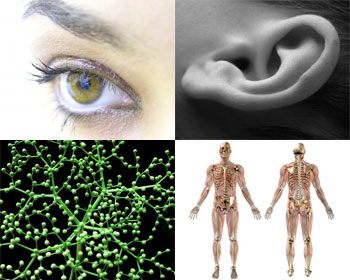A Publication of the
Applied Math and Science Education Repository

The AMSER Science Reader Monthly aims to provide educators with a useful package of information about a particular topic related to applied math and science by combining freely available articles from popular journals with curriculum, learning objects, and web sites from the AMSER portal. The AMSER Science Reader Monthly is free to use in the classroom and educators are encouraged to contact AMSER with suggestions for upcoming issues or comments and concerns at [email protected].
This month's AMSER Science Reader Monthly topic is Bionics.
Bionics
Article
by Josh Fischman
Synopsis and resource annotations by Max Grinnell

The word "bionic" has been used in science fiction for years, but recent advances have made robotic arms, eyes, and ears a reality. Bionics is the study of mechanical systems that function like living organisms or parts of living organisms and the term is used to describe those individuals whose body parts are replaced by devices embedded in their nervous systems that respond to commands from their brains. This thoughtful National Geographic piece by Josh Fischman explores the cutting-edge world of bionics.
The article begins by profiling Amanda Kitts as she works with her students at the Kiddie Kottage Learning Center in Tennessee. She is able to inform (and entertain) her young charges with her robotic arm, which is made out of flesh-colored plastic, three motors, a metal frame, and rather sophisticated electronics. Amanda received this robotic replacement arm after she lost her own arm in a car accident in 2006. This new arm uses sensors that detect impulses from her brain to move the arm, hand, and fingers. The arm has extended her own physical abilities and has also helped her to cope with the emotional loss of this limb.
Many patients suffering from limb loss retain the nerves and brain functionality to use replacement limbs. Within their brain, "below the level of consciousness, lives an intact image of that arm, a phantom." In recent years, advances in microscopic electrodes and surgical implants have transformed the lives of more than those with missing limbs, it has begun to help those who were previously unable to see, hear, or in many cases, move.
Bionics, which combines mechanical engineering, anatomy, and robotics, is made possible by many trial and error sessions and experimentation and the field is often defined as a restoration process. According to Joseph Pancrazio, program director for neural engineering at the National Institute of Neurological Disorders and Stroke, "That's really what this work is about: restoration, when a person with a spinal-cord injury can be in a restaurant, feeding himself, and no one else notices, that is my definition of success."
Todd Kuiken at the Rehabilitation Institute of Chicago (RIC) has been working on the "bionic arm" for years; Kuiken knew that nerves in an amputee's stump could still carry signals from the brain, and he was able to develop a connection from the brain to the prosthesis. It was a complicated process that involved some experimentation, but eventually he was able to make these vital connections. The technique remains experimental, but it is hoped that eventually it could be as common as the hearing device known as the cochlear implant.
The piece ends by examining the improvements that have been made with cochlear implants, bionic eyes, electrodes for quadriplegics, and the possibility of using neural prosthetics to allow afflicted patients to move remote objects with their minds.
Found below is a list of useful resources that will illuminate and enhance understanding of the topics found within this article. The first link will take visitors to the homepage of the Robotics Academy at Carnegie Mellon University. The site includes educational resources for educators, including lesson plans and videos. The second link leads to a lesson plan designed to help students learn how to develop a functioning robot arm with everyday materials. Moving on, the third link leads to a paper from researchers at McGill University that will be most useful for college professors who might be looking into developing a course in medical robotics. The fourth link leads to the University of Toronto's Artificial Perception Lab, which includes materials related to their work on artificial information systems and robotics. The last link leads to a site that provides some educational activities about the human body and how the skeletal system functions and will help students understand some of the anatomy discussed in the article above.



